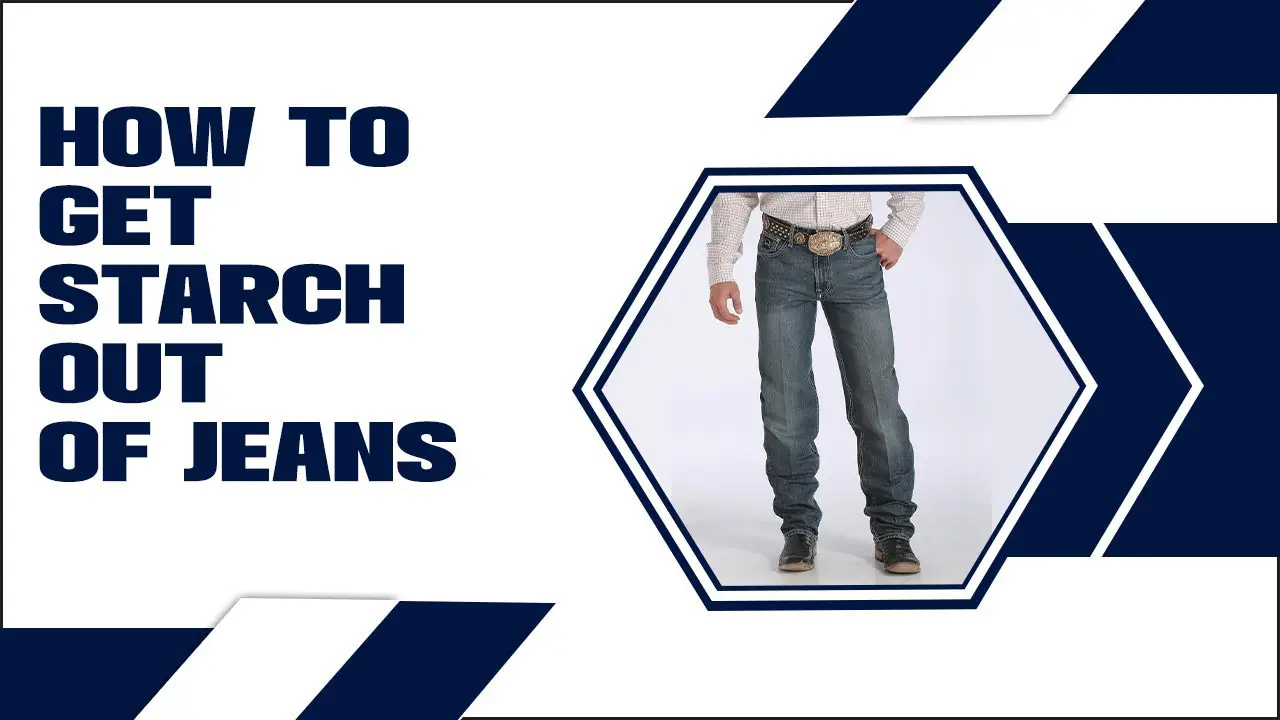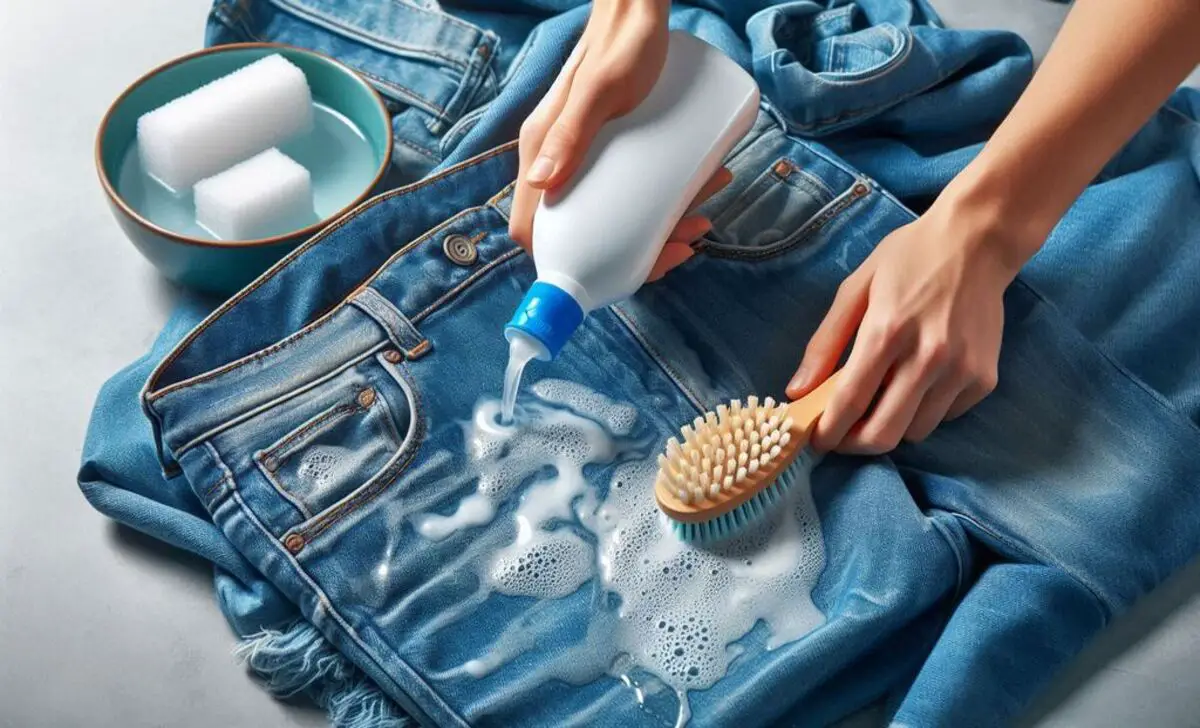Removing starch from jeans is a common need for those who want to maintain the softness and flexibility of their denim. Starching jeans can provide a crisp, clean look, but over time, it can cause the fabric to become stiff and uncomfortable. Whether the starch was applied at the factory, by a dry cleaner, or at home, understanding how to remove it effectively can help preserve the comfort and durability of your jeans.
Maintaining the natural feel of denim enhances wearing comfort and extends the lifespan of your jeans, ensuring they remain a staple in your wardrobe for years to come. This guide will provide practical steps to help you get starch out of your jeans and restore their original softness.

Assessing Starch Levels
Determining if your jeans are starched and understanding the level of starch present is the first step in restoring their natural softness and flexibility. Starch can be applied in various forms, including heavy starch, spray starch, or liquid starch, each affecting the denim fabric differently.
Identifying Starch in Jeans:
- Texture Check: Feel the fabric; starched jeans will be noticeably stiffer and less flexible than non-starched jeans.
- Visual Inspection: Look for a crisp, glossy appearance, which is often a sign of heavy starch application.
- Movement Test: Bend and move the jeans; if they hold their shape rigidly and don’t drape naturally, they likely have a significant amount of starch.
Effects of Starch on Denim Fabric:
- Reduced Flexibility: Starch makes the denim less pliable, leading to discomfort during wear.
- Increased Wear and Tear: Stiff jeans can be more prone to creasing and potential damage at stress points.
- Altered Appearance: Heavy starching can create an artificial, overly structured look that may not be desirable for all styles.
Assessing the level of starch in your jeans will help you determine the best approach for washing and restoring their natural feel. Proper assessment ensures that you can effectively remove excess starch and maintain the comfort and durability of your denim.
Preparing Your Workspace
Start by setting up a suitable area for cleaning your jeans. A clean, flat surface, such as a countertop or laundry table, is ideal. Ensure the area is free from contaminants like grease stains, which could transfer onto the jeans during cleaning. Lay down a clean towel or cloth to protect the surface and your jeans.
Next, gather the necessary materials. You’ll need:
- Mild detergent: Gentle enough to clean without damaging the fabric.
- Soft brush: Ideal for scrubbing without causing abrasions.
- Large basin or sink: This is used to soak the jeans.
- Clean towels: For blotting and drying the jeans.
- Warm water: To help dissolve the starch.
How To Get Starch Out Of Jeans: Step-By-Step Guide

To remove starch from jeans, soak them in cold water mixed with a mild detergent for about 30 minutes. Gently scrub the affected areas with a soft-bristled brush to help loosen the starch. Afterwards, rinse the jeans thoroughly with cold water.
If the starch remains, create a solution of equal parts white vinegar and cold water and soak the jeans for 30 minutes. Rinse the jeans again and let them air dry. Repeat the process if necessary until the starch is removed.
1.Washing Jeans
Washing Jeans To Remove Starch
Removing starch from jeans involves choosing the right washing method to ensure the denim regains its natural softness and flexibility. Hand and machine washing can be effective when dealing with a light starch solution or heavily starched clothes.
1.Hand Wash:
- Preparation: Fill a basin with lukewarm water and add a small amount of mild detergent.
- Soaking: Submerge the denim jeans and let them soak for 30 minutes to loosen the starch.
- Rinsing: Gently agitate the jeans, then rinse thoroughly with clean water until all soap and starch residue is removed.
- Drying: Hang the jeans to air dry to avoid any shrinkage or damage from high heat.
2.Machine Wash:
- Settings: Use a gentle cycle with cold or lukewarm water to prevent damage to the fabric.
- Detergent: Add a mild detergent, and avoid using any additional fabric softeners or starch.
- Extra Rinse: Select an extra rinse cycle to wash out all starch solution and detergent fully.
- Drying: Opt for air drying or use a low heat setting if using a dryer.
For both methods, spraying the jeans with water and white vinegar from a spray bottle before washing can be helpful. This helps break down the starch.
2.Using Vinegar Solution

Vinegar is an effective and natural solution for removing starch from jeans. It offers multiple benefits for maintaining the softness and flexibility of the denim fabric. The acetic acid in vinegar helps break down the cornstarch, making it easier to wash away.
Benefits Of Vinegar:
- Natural and non-toxic, making it safe for fabrics.
- Helps to soften denim fabric by breaking down starch residues.
- Prevents buildup that can cause stiffness.
Steps To Use Vinegar Solution:
- Prepare the Solution: Mix one part white vinegar with three parts water to create a diluted solution that is safe for denim.
- Soak the Jeans: Submerge your jeans in the vinegar solution and let them soak for about 30 minutes. This allows the vinegar to penetrate the fibres and break down the starch.
- Wash the Jeans: After soaking, wash the jeans in the washing machine using cold water and a mild laundry detergent. The detergent will help remove any remaining starch and vinegar odour.
- Rinse Thoroughly: Ensure that the jeans are rinsed thoroughly to remove all vinegar and detergent residues.
- Dry Naturally: Air dry the jeans to prevent any shrinkage or damage from high heat.
3.Rinsing And Drying
Proper rinsing and drying are crucial to effectively removing starch from jeans and restoring their natural softness and flexibility. Starch can create stiffness in delicate fabrics, and removing it without causing damage is important.
To begin, fill a basin with cold water and add a small amount of mild dish detergent. Gently agitate the water to create suds, then submerge the jeans and let them soak for about 30 minutes. This process helps to break down and loosen the starch residue embedded in the fabric.
After soaking, rinse the jeans thoroughly with cold water to remove all traces of detergent and starch. When drying, avoid using high heat settings, as they can cause the starch to set further into the fabric.
Instead, opt for air drying by hanging the jeans on a clothesline or laying them flat on a clean, dry surface. If you prefer a dryer, choose a low or no-heat setting to tumble dry the jeans gently. This method helps maintain the integrity of the denim while ensuring the removal of any remaining starch.
Rinsing Techniques:
- Soak in cold water with mild dish detergent to break down starch.
- Rinse thoroughly with cold water to remove detergent and starch residue.
Drying Methods:
- Air Drying: Hang jeans on a clothesline or lay them flat to dry naturally.
- Tumble Drying: Use a low or no-heat setting to prevent starch from setting and to preserve fabric quality.
4.Additional Tips For Stubborn Starch

Sometimes, jeans can become heavily starched, making it challenging to restore their natural softness. For stubborn starch, extra steps may be needed to ensure your jeans regain their flexibility and comfort.
Methods For Treating Heavily Starched Areas:
- Vinegar Soak: Soak the jeans in a solution of one part white vinegar to three parts water for 30 minutes. Vinegar helps break down the starch without damaging the fabric.
- Use of Dryer Sheets: Place the jeans in the dryer with a dryer sheet. The dryer sheet will help soften the fabric and reduce stiffness.
- Repeated Washing: Wash the jeans multiple times in warm water with a gentle detergent. Each wash will gradually remove layers of starch.
Conclusion
Effectively removing starch from jeans involves a few simple methods to ensure the fabric regains its natural softness and flexibility. Techniques such as vinegar soaks, using dryer sheets, and repeated washing can help break down stubborn starch.
Additionally, avoiding excessive starch use in the future by applying it sparingly and considering alternative softening methods will preserve your jeans’ comfort and quality. Maintaining the softness of your jeans enhances wearing comfort and extends their lifespan, ensuring they remain a staple in your wardrobe. Following these steps lets you keep your jeans looking and feeling great while enjoying their durability and style.
Frequently Asked Questions
1.What Does Starch Do To Blue Jeans?
Starching blue jeans can make them stiff and uncomfortable to wear and cause the fabric to deteriorate over time. Moreover, starch attracts dirt and dust, quickly making the jeans appear dirty. It is advisable to avoid using starch on blue jeans or use it sparingly.
2.Why Do People Starch Jeans?
People starch jeans to achieve a more rigid and crisp texture. Starching helps maintain the shape of jeans and minimizes wrinkles. Additionally, some individuals starch their jeans for a vintage or classic appearance. However, excessive starching can eventually harm the fabric.
3.What Causes Starch Buildup On Jeans?
Starch buildup on jeans occurs due to excessive use of starch spray or infrequent washing. Hard water and mineral deposits can also contribute to the buildup. Wearing jeans before they are completely dry after washing can lead to starch accumulation.
4.How Do You Soften Jeans With Baking Soda?
Mix 1 cup of baking soda with water in a bucket to soften jeans with baking soda. Soak your jeans in the solution for about 30 minutes before washing them. Baking soda breaks down stiff fibres, resulting in softer jeans.
5.What Are Some Effective Ways To Remove Starch From Jeans?
To effectively remove starch from jeans, you can try soaking them in a mixture of cold water and vinegar to break down the starch. Scrubbing the jeans with baking soda and water can also help, followed by rinsing with cold water.
6.How Often Should I Wash Starched Jeans?
For starched jeans, washing them after wearing them approximately 4-6 times is recommended. This helps maintain the stiffness and shape provided by the starch while also preventing unnecessary wear and tear from frequent washing. Adjust washing frequency based on how often you wear them and the level of dirt or odor they accumulate.
7.Can I Use Fabric Softener To Remove Starch From Jeans?
Yes, fabric softener can help remove starch from jeans. Add fabric softener to the washing machine during the rinse cycle. This will help break down the starch and make the jeans feel softer. Be sure to follow the fabric softener’s instructions for the best results.
8.Will Removing Starch Affect The Colour Of My Jeans?
Removing starch from jeans should not significantly affect the colour. However, frequent washing, especially with strong detergents or hot water, can cause some fading over time. To preserve the colour, wash your jeans in cold water, use a mild detergent, and turn them inside out before washing. Avoiding prolonged exposure to direct sunlight while drying can also help maintain the colour.



